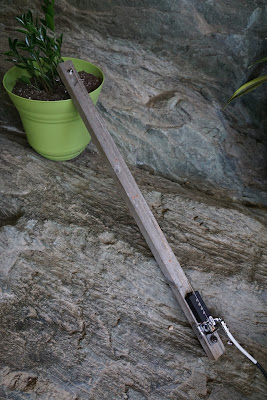Okay, I just made up the part about it being a challenge, but it seems like you can just throw "challenge" after any noun and have it become an internet phenomenon, so who knows? :P
The challenge, such as it was, was to make an electrified string instrument surpassing all previous records of cheapness. Cost: $0. Maximum cost if the parts were bought new? $5 (ish). Mission accomplished!
First, let's reflect on a few previous records for cheapness:
The Lightswitch Strat, a.k.a. Mojo Machine: some scrap parts, new neck and tuners, would've been about $80 max.
Blondie, made of scraps and leftovers, only tuners bought new. Would've been about $70 max.
The Les Plywood, made of not only guitar scraps, but warped and dirty plywood scraps from the garage. Couldn't have been more than $50 max.
Alright, I guess it's cheating to put this... stick in the same category as actual guitars, but it blew away the previous records for absurd cheapness resourcefulness.
Step 1: Find stick. I found a random stick, probably for making stakes or something, gray and weathered. Perfect.
Step 2: Assemble stick. I cut the stick in half and took a planer to one side of each. Gluing these together makes it one wider, stronger stick, which is necessary since I didn't find anything for ridiculously cheap that seemed like an effective truss rod.
Carved a few little ghetto dowel joiners, drilled holes in both sides so the dowels could hopefully hold the warped sticks in line while gluing.
A bunch of clamps and it's straight-ish. None of this was truly necessary, but I wanted to try joining wood like this for practice anyway.
From left to right: input jack holder, bridge mount, nut. Yup.
I had a leftover input jack but unfortunately no matching nut to hold it on... some pliers clamped the metal piece around it, which holds it surprisingly securely, and doubles as an electrical ground!
Step 4: Put this s**t together! First part was "routing" out a space for the pickup magnet to fit nicely (and make the pickup fit below the string). Then the pickup (half of a Squier P-Bass pickup) was gently secured, with rusty nails and a big mallet.
The input jack mount went on next, just behind the pickup, held in with one screw because I couldn't find enough rusty screws for the side mounts. Works fine.
Next came the bridge mount, bolted through the end, with a washer underneath to ensure that perfect action one expects from an instrument of this caliber.
While the bridge holds nicely in general, I found it immediately bent downwards when tension was applied to the string - some circular metal doodad wedged underneath fixed it nicely.
Tuner installation was as easy as drilling a hole, and the "nut" was hammered in at a place that looked convenient. I originally wanted to use a screw because the string could rest between threads, but screws more brittle (zinc?) construction meant they just snapped instead of bending. A nail with a little groove filed in worked fine.
Cut the wires to length and soldered, easiest soldering job ever.
Then I strung it up with a Rogue high-e string, since I got a value pack to fix those pesky e-string breaks (true to Murphy's law, my e-strings stopped randomly breaking when I bought spares).
Then, a few copper nails worked to add precisely calibrated guesstimated by ear "fret markers" at the 7th, 12th, and 24th.
Add a pick, a slide, and the amp of your choice, and start twanging. I suck at slide guitar, so wouldn't dare torture you with a demo, but rest assured, it sounds pretty much exactly like playing only the high E string on a guitar with a slide.
Who knows, I might try boring out the bridge and reinforcing the nail sometime to add a heavier string and make this more of a "djent stick" later on... https://www.youtube.com/watch?v=IyQOw-_H4yE
![[Mattwins]](https://blogger.googleusercontent.com/img/b/R29vZ2xl/AVvXsEgEy2dr7hX_nicvRhz4bxUFEoP_GPqBybD6lc0fwB83oIJo5s3tR3Qal9gBewkZ2l_egelA4NJ4SaMEWcs1l4QzdVYNdDcLO-8p8s4GEVdcMHt9xVrbDc2tGNaiOFFshWzgrUnPiNBUBfkU/s1600-r/logo2+-+Copy.png)

















No comments :
Post a Comment
Questions, comments, concerns, complaints? Leave your thoughts below!